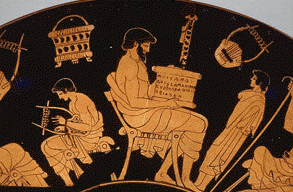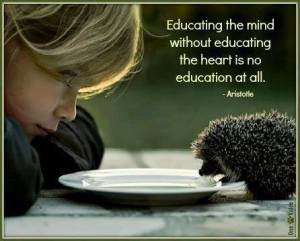This is Part IV in our BFB Fundamentals Series.
By Rea C. Berg
Dear Friends,
In Part IV of our series BFB Fundamentals, we are exploring the question of whether or not Beautiful Feet Books is classical in nature. As we noted in the
previous post, until the definition of
classical is clarified, the question can become one of semantics and may lead to simplistic conclusions. Because classical is currently the homeschool paradigm
de jour, examining some of its well-accepted tenets should prove helpful as you determine which path is right for you and the students you serve.
What does contemporary classical homeschooling mean?
Classical education as a home schooling model first became popular as the 20th century gave way to the 21st and has remained so since. For those of us who began home schooling in the 1980s, classical education was the new kid on the block. As with any fad, it swept many in its wake and provided some folks with solutions to the failing standards they saw in public education as well as in the more relaxed homeschooling model. Its emphasis on a rigorous academic approach seemed to guarantee the creation of scholars who would take positions of leadership in law, medicine, government and so forth. This would be achieved through implementing the trivium as we noted in our previous post.
Stage One: The Grammar Stage

Early Greek educators did not view education as the process of three distinct stages; as soon as students could read and write they were reading the classic Greek texts.
Modern classical proponents ascribe to the notion that learning takes place in three distinct 4-year phases of a student’s life. While these phases may seem to correlate to the physical and intellectual development of the child, the bland acceptance of them can prove problematic. In the grammar stage of the classical approach (also known as the poll-parrot stage), emphasis is placed on pouring into the student facts (indeed “masses of information”-as one promoter put it) as children are supposedly sponges ready and willing to soak up facts of every kind, and can easily memorize these facts. Theoretically, later on, in the logic stage, these facts will be drawn upon as the child begins to reason. While this approach fits some students well, especially those gifted in memorization, other students, particularly those not gifted with the ability to retain masses of disparate facts, flounder. The focus on pouring information into a young child is based on the notion that in the grammar stage children will unquestioningly accept what is offered.
But is this 4-year cycle based upon a truly classical approach to education? Did the ancients view education through this 12-year paradigm to which modern classical proponents ascribe? As Diane Lockman points out in her helpful article “
Classical Education Made Easier“, the ancient Greeks did not separate the grammar, logic, and rhetoric stages. Students became proficient in reading, reasoning and speaking as they studied the classic texts of Greek literature with an emphasis on copy work and reading and reciting aloud.
An authentic classical Christian education, as developed during the ancient Greco-Roman world and later refined by the Western Europeans and American colonists, involved mastering three fundamental skills so that the student could then explore the deeper meaning of abstract ideas for the purpose of influencing society. Three chronological stages were never part of the original interpretation.
The Charlotte Mason approach asserts that all children, regardless of age, are capable of reason, delight, appreciation of beauty, and that “Education should aim at giving knowledge touched with emotion” (
For the Children’s Sake). Pouring information into a child for the mere goal of “filling the brain with facts” defies the essential nature of classical education–the desire to teach children
to think. True education cannot ignore the spirit of the child, his basic need to feel connected in some way to the studies at

hand. At Beautiful Feet we believe this is done through literature’s emotional connection–the ability to identify with others through the power of stories of literary beauty and historical import. A quick narrative read of historical facts (standard fare in most classical approaches) that offers no literary beauty and no connection to the great questions of the human condition, fails to meet the standards of a truly classical education.
Begin at the beginning: the four-year cycle of history study?
Additionally, the current classical notion that history studies must begin at the beginning (with ancient history in first grade) is another layer of artificial construction upon an already artificial 12-year model. Classical education’s promotion of a four-year cycle of history instruction seems reasonable and the repetition (“what we don’t get the first time around, we’ll be sure to pick up next time!”) provides reassurance. While the four-year cycle approach does provide that revisiting, it doesn’t consider the question of age and developmental appropriateness for subject matter. This concern is dismissed by promoting the notion that while studying ancient history with your first grader, one can just focus on mummification, gladiators, and chariot races; in effect this belies the basic notion that ancient history can be taught to a first grader. The resultant “classical” studies are cultural in nature, not historical. Indeed, Oxford Reference defines history as “the study of past events, particularly in human affairs”–the study of history necessitates the focus on events.
History, taught classically . . .
So how does one approach historical studies with a truly classical view to nurturing in young students reading, reasoning, and speaking skills? In essence, this can be accomplished in much the same way as the ancient Greeks did it–by exposing children to the best age-appropriate literature which is relevant to their times and culture. For a young American child this means the best children’s books on the early saga of America’s great story, much as the Greeks read Homer and studied Plato–the stories of their ancestors, the history of their nation. A child gifted with the knowledge and appreciation of his own historical heritage better understands his or her place in the world and from that foundation can embrace the beauty and the heritage of other nations and cultures.
So, how does this answer our question, “Is Beautiful Feet Books classical?” If one looks at some contemporary notions of classical, then the answer would be, “No.” On the other hand, if one perceives classical as incorporating Socratic reasoning and discussion, engaging with timeless literature (age appropriate), eschewing the use of textbooks and bland narrative works, and involving students in the Great Conversation about the important issues of the human heart, then yes, Beautiful Feet Books is classical.
We would love to hear what you think! Chime in below in the comments section and share your thoughts. Don't forget to check out our Facebook and Pinterest pages. To learn more about Beautiful Feet Books, click here.
And if you've enjoyed this, please feel free to share using the buttons below!





